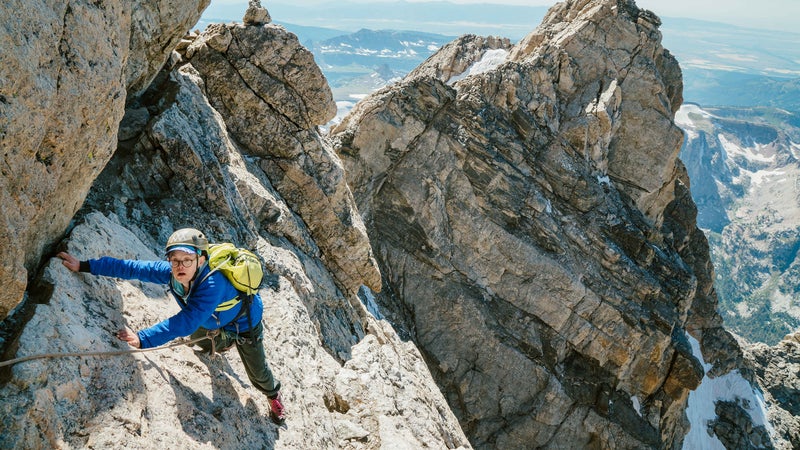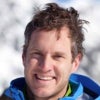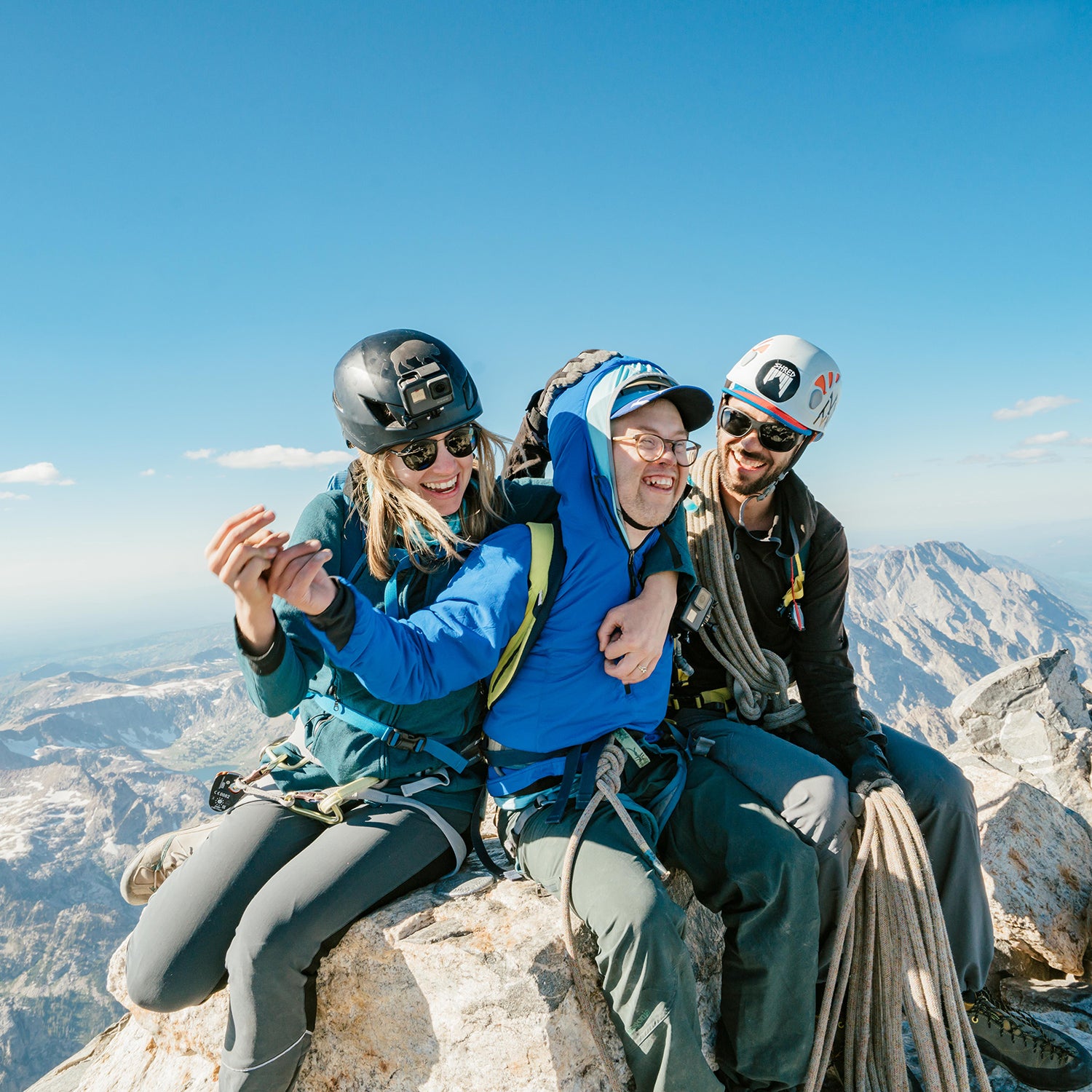I got the text around 8 p.m. on Friday evening. “They made the summit,” my friend Eric Henderson wrote. A few hours earlier, around 5:30 p.m., Andrew “Bob” Harris became the first person with Down syndrome to climb the Grand Teton. There was also photographic proof. The next text contained a summit shot, a sun flare in the upper right corner on a cloudless day in the Tetons, with Bob and his future-brother-in-law Max Hammer, a professional skier and mountain guide, atop the jumbled apex of rock.
I had been loosely following their summit attempt for the past month or so, ever since I met Bob, who also sometimes goes by Ducky, an old family nickname, and Max at the Outdoor Retailer Show, the industry’s biannual gear fest, in Salt Lake City. Eric had recently started his own PR firm and was helping one of his first clients, the , launch an outdoor initiative. Eric and I both have daughters with Down syndrome and were both fired up about bringing our two worlds together.��
At the show, one of NDSS’s main goals was to spread the word that people with Down syndrome are ready and willing to work. A handful of companies in the industry already employ people with Down syndrome—and they were hoping to convince more. During a panel discussion, Max, who is , and Bob talked about Bob’s experience working at Patagonia as a prep cook.��
One of the other topics of conversation was NDSS’s athlete ambassador program. Most of the people in the program run marathons and compete in triathlons to advocate for the organization, but Bob and Max had something else in mind. “I guess the idea was mine,” says Max, a part-time guide for Jackson-based , which specializes in taking clients climbing in the Tetons.��“It was something we thought and talked a lot about for years. And then, maybe a year or so ago, we realized that we might actually be able to do it.”
Climbing the Grand Teton is no easy feat for any human, regardless of how many copies of the 21st chromosome you’ve got. A toothy, 13,776-foot high spire, the Grand is one of the most recognizable peaks in the country, looming 7,000 feet above the valley floor. Along with the rest of the Teton range, it’s so absurdly beautiful and soaring it almost looks fake—like a cardboard cutout of the biggest, most jagged peaks someone could imagine. The approach involves a steep 6.5-mile hike, 5,000 feet of elevation gain, and some Class 3 scrambling. Then you reach the technical part of the climb. Which, if you choose one of the main routes to the top, involves some very exposed fifth-class routes. While the fastest superhumans among us can do the whole thing car-to-car, running and scrambling without ropes, in just under three hours, most people take two days to do it, hiking in, then��roping��up for the final technical pitches.��
“As a father to a child with Down syndrome, Bob’s climb confirms that DS has no limitations. If you have the skills, the strength, and the determination, no summit is too high.”��I couldn’t agree more. My daughter Nina is only two and a half. We still have a lifetime of adventures together.
If anyone had a handle on whether or not 32-year-old Bob could make it to the top, it was Max's wife and Bob's sister, Amy. Amy and Max, both 29,��live in Reno, where Amy is a cardiac ICU nurse. Max and Amy, who have��known each other since they were teens, “have been in love with each other for basically ever,” says Max. They've been��living together as a couple for the past four years and are��getting married on August 26.��Two and a half years ago, Bob moved in with them. He still sees his parents and older brother, who live nearby in Tahoe, California,��but Max and Amy have become his “host home providers,” in the official language of the state. Or, as Max puts it, “I tuck him in every night.”��
Being outside and exercising have always been a priority for Bob and Amy’s family. “He paddleboards, skis, snowshoes, rides horses with my mom, basically everything we do,” says Amy. He loves to run and hike, and started climbing with Amy about 10 years ago. He especially liked hard hikes—his favorite trail is the Precipice Trail in , a difficult, steep, exposed seaside hike, with Via Ferrata-style iron rung ladders in spots.
In his mid-twenties, Bob had some serious health problems, which made it very difficult for him to eat. He ended up in the hospital for a few weeks and for several years he ate exclusively through a feed tube. Slowly but surely, with Amy leading the charge, Bob’s family got him eating solid food again and back outside exercising. “We’re told that people with Down syndrome are slow, and you can’t take them that far,” Amy says, “but Bob is pretty fast and he can go forever.” When Bob started tackling increasingly tough and long day hikes, and dubbed himself “Bob Hammer,” the origin of the Bob nickname, Amy and Max realized that their Grand Teton idea was no longer a pipe dream.��

About a year ago, the trio started going to the gym and local crags together, practicing rappelling, short roping, and multi-pitch climbing. Bob has difficulty doing certain things like clipping in and out of the rope and cleaning gear, but the threesome slowly figured out a unique climbing style that worked for them. Usually, that means Max in front, and Amy right next to (or in front or behind) Bob. Earlier this summer, they��felt like they were ready. Max and Bob and Amy would be one rope team, and they’d be accompanied by , fellow Exum guide Zahan Billmoria, and Julie Ellison, the editor of . “Bob was in really good shape,” says Amy. “Our biggest concern was snow”—which can linger in the saddle all summer long—“and Bob hates climbing on snow.”��
Big pushes in the mountains rarely go exactly as planned, and Max and Amy and Bob’s summit day was no different. While the trio had practiced all the individual skills required to scale an objective as big and technical as the Grand Teton, they hadn’t had the opportunity to link them all in one big training or shakedown outing. While Bob moves well and is comfortable on belay and on the trail, it was the in-between terrain that slowed them down. Climbing the Grand involves hiking up lots of sections of loose rock and scree fields, spots that��took the trio much longer to navigate than planned. “Bob was getting frustrated, and there was lots of spotting, coaching, and short-roping,”��says Max.����
Bob’s a big hummer—as in he hums a lot when he does stuff—and Max and Amy have become pretty attuned to what his different kinds of hums mean. “He fell on his butt a few times,” says Amy, “but I could tell by his hums that he was mostly having fun.” To keep his spirits up, they sang songs (“Lots of Adele,” Amy told me, “Bob loves Adele”), and Amy kept up a more or less constant stream of encouragement. “I’ve never heard Amy talk so much,” Max recalls. “She basically never stopped moving and never stopped talking and singing and being silly and keeping Bob’s spirits high, the entire time.”
Initially, Max and Amy had planned on climbing the Upper Exum Ridge route. It’s slightly longer and a bit more technical than the other standard route, Owen-Spaulding, but it was also a bit more suited to the group’s unique climbing style. (Bob is very comfortable friction climbing on “slabs,” rock faces that are less steep than vertical, which the Exum has more of.) Ultimately, they decided that Owen-Spaulding would be a safer, faster option. As soon as they roped up, they started��making better time. Whereas most people get more tense when climbing exposed terrain, Bob doesn’t seem to mind. “I kept hearing lots of laughter,” Max says. “There’s a 2,000-foot sheer drop and he’s just giggling.”
Here was Bob, on the top of the Tetons, the most happy they’d ever seen him in his life.
Roughly fifty feet below the summit, the group encountered another unforeseen complication. The Grand sees a lot of traffic, especially in late summer, and a climber in another party lost his footing while down-climbing and had suffered serious injuries. In an instant, the entire vibe of the climb changed. At first, Amy, a nurse, wanted to assist in the rescue and they debated whether or not they should continue. “It was really hard and upsetting and emotional,” says Amy. “We talked through all our options and ultimately decided to keep going. Bob is a really empathetic guy, so we tried to downplay the severity of the situation with him and keep our energy positive, but it was very difficult.” In the end, two members of the trio’s larger support team—Fisher and Exum guide Billmoria—decided to help the injured climber and coordinate the eventual short-haul helicopter evacuation that was required.��
A short while later, Bob and the remaining members of the group made the summit, at which point all those mixed emotions were washed away, at least momentarily, for Max and Amy. “It was a family moment and it was indescribably cool,” says Max. “We pretty much all lost it. There were a lot of tears of joy.” While neither Max nor Amy ever doubted that Bob could do it, they hadn’t been able to anticipate how powerful and emotional the experience would feel. But here was Bob, on the top of the Tetons, the most happy they’d ever seen him in his life.��
Back in the valley, it was all eclipse. Jackson was smack dab in the path of totality, and the entire town had become subsumed with the influx of visitors and hoopla. When I talked to Bob a few days after the climb, he had just gotten back from a trail run with his dad and was still pretty amped up about the experience. When people asked him what was next, he often replied “Halloween,” one of his favorite holidays. (He’s planning on going as a pirate.) He acknowledged that it was the hardest thing he’d ever done, and when I asked him if he’d do it again, his reply was pretty typical of all mountaineers: “Maybe in a year,” he told me. Also typical was his response to my question about what his favorite part was: The top.��
After they made the summit, they slept at the saddle before descending back to the car the next day. At about 3 a.m., Amy woke up to find Bob sitting straight up in the tent, watching the day’s first climbers start their own summit bids in the pre-dawn darkness, transfixed by the stars, the headlamps slowly heading up the rocks above, and the sheer awesomeness of it all. The outpouring of support and positive feedback, both on social media and in person that Bob and Max and Amy have received has been the most rewarding aspect of the climb. And it’s sure to continue. Julie, the editor from Climbing��magazine, is planning on writing and the are working on a documentary film.��
It’s been especially inspiring and impactful to those of us who have children or loved ones with Down syndrome. “Bob's summit last week is so much more than one climb to one of the world's most iconic mountains—it's about showing the world that people with Down syndrome have their own hopes, dreams and aspirations,” says��Sara Hart Weir, president of NDSS. “As the leading human rights organization for all individuals with Down syndrome, our job is to break down all barriers to allow people with Down syndrome to reach their full potential.”
Or, as Eric put it, “as a father to a child with Down syndrome, Bob’s climb confirms that DS has no limitations. If you have the skills, the strength, and the determination, no summit is too high.” I couldn’t agree more. My daughter Nina is only two and a half. We still have a lifetime of adventures together, and there are many peaks to climb.


